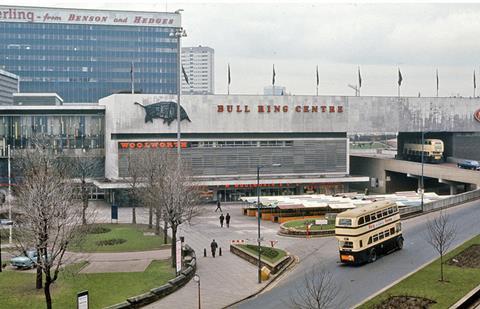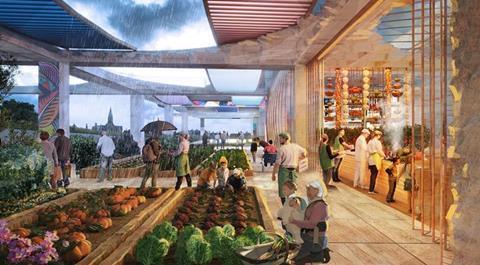Planning largely saved Britain’s town centres from the ravages of out of town shopping, but that just forced the malls onto the high street, writes David Rudlin

We often deride the effectiveness of the planning system but when it comes to retail policy, planning may have saved our town centres, but at what cost?
Back in 1964 there was a huge planning battle in Haydock. A developer had put forward plans for a million square foot shopping centre on an out-of-town site between Liverpool and Manchester. To put this in context the Bull Ring Shopping Centre in Birmingham, which opened the same year, was just 350,000sqft.
For the public enquiry a team from Manchester University assessed the impact of the mall. They concluded that in terms of disposable income, appetite for ‘durable goods’, population growth and car ownership, the UK was just a few years behind the US in its demand for this type of shopping. However, while they estimated that the centre would have small but measurable impacts on Manchester and Liverpool (12%), it would devastate local towns like St. Helens, Wigan and Warrington. So, the appeal was refused and national policy changed to prevent out-of-town shopping centres.
And it worked! At least for twenty years, until the arrival of the Thatcher Government (as described in a previous column).
The UK built its malls in town centres. The Bull Ring was followed by the Merrion Centre in Leeds (1964) The Elephant and Castle (1965), The Tricorn Centre in Portsmouth (1966), The Victoria Centre and the Broad Marsh Centre (of which more in a moment) in Nottingham (1972 and 1973), the Kirkgate Centre in Bradford (1974), Eldon Square in Newcastle (1976), and, biggest of them all, the Arndale Centre in Manchester (1979). Wikipedia lists 413 Malls in the UK, most of which are in-town with some places having as many as three.

This is nothing compared to the US where there are 1,800 malls and where a town like Atlanta (with a population of 2 million) has 12 malls, all out-of-town. No wonder Main Street died in the US in a way that didn’t happen in the UK - thanks to the planning system!
Planning came to the rescue once more in the 1990s following the out-of-town retail boom unleashed by the Conservatives. My old practice URBED produced a landmark report for government, Vital and Viable Town Centres in 1994 and government policy was changed to include a sequential test - no new retailing could be built out-of-town if a suitable site existed in-town. It worked - in 1994 86% of new retail was out-of-town, by 2001 the same percentage was being built in-town. Planning to the rescue once more!
But, (I’m sure you saw that coming) pretty much all of the new town centre retail space was in malls. These great alien, inward-looking structures were shoehorned into traditional town centres, destroying independent retail and traditional street patterns. I was at an event in Manchester just before Christmas and the older members of the audience still mourn the creative district full of bars and venues that was destroyed by the Arndale. Planning may have saved our town centres but at what cost?
> Also read: The Professor and the Miner’s Son: the story of Britain’s biggest shopping mall
Part of the cost was economic. In our book High Street, the places with the highest vacancies were those that had built new malls in the last 10 years. Encouraged by retail agents they had built these malls to attract new national retailers only to find that it was retailers from the old centre who relocated, the biggest victim often being the town’s older mall.
In the US there 300 derelict (or zombie) malls - so many that they have generated their own photography genre. In the UK, the Local Data Company estimates that there are 70 malls that are unviable, five of which have a vacancy rate of over 80%, while Knight Frank estimate that there are a further 200 malls at risk. These, of course, are slap bang in the middle of our towns.

This has all been at the forefront of our minds over the last year as we have worked on the Broad Marsh Shopping Centre in Nottingham. A victim of the collapse of Intu, it had already been suffering because of the expansion of the city’s other mall, the Victoria Centre (also formerly owned by Intu). In 2021 Thomas Heatherwick suggested stripping it back to its frame and filling it with creative things. A great idea in principle, provided it can be made practical and viable, which has been our job.
As we argue in High Street we can redevelop these malls for housing and offices, but we also need to think about what happens at street level. How can we reuse these malls in a way that replicates their former pulling power while replacing their identikit retailers and inward looking layout? If we can get it to work, as we will do in Broad Marsh, the legacy of these old malls could become a huge opportunity to revitalise our town centres.
> Also read: Heatherwick’s plans for £500m makeover of 1970s shopping mall in Nottingham revealed
> Also read: Green light for Corstorphine & Wright’s Cambridge shopping centre reinvention
Postscript
David Rudlin is director of Urban Design at BDP and visiting professor at Manchester School of Architecture.
He is a co-author of High Street: How our town centres can bounce back from the retail crisis, published by RIBA Publishing.
















2 Readers' comments